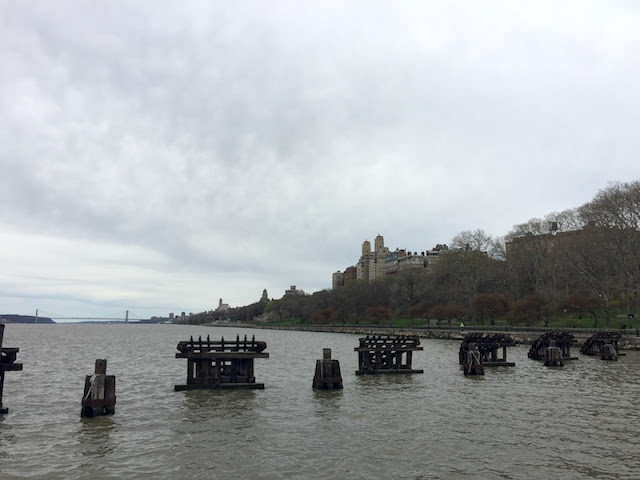From the Waterfront to Joan of Arc: Locating the Past in Riverside Park
 |
| A blooming tree near the W. 79th Boat Basin in Riverside Park |
A full picture of Riverside Park requires walking back and forth among the tiered slopes, so the walk is less a straight line and more a meandering path. Walking along the water here (increasing biking and running are the main pursuits) may be excellent for exercise and recreation, but much is missed in terms of New York history. As the city continues to revamp the waterfront, it’s worth contemplating the ways in which these efforts inadvertently disconnect people from a shared past. A fine day can be had walking the waterfront in the park, for example, but you’re going to miss Joan of Arc.
 |
| From Pier 1 in Riverside Park South, an overview of the Riverside Park landscape |
The terrain cascades like drapes over descending terraces from the rocky walls of the Upper West Side down to the Hudson. Frederick Law Olmsted, and later Calvert Vaux, originally designed Riverside Park to mimic the landscape of the Hudson Valley. So, at its inception, the park offered a break from the turmoil and grit of the city.
The park expanded and evolved through the decades, with the bucolic site serving as the hallowed ground for many memorials, including the tomb of General Grant at its northern end and the Soldiers’ and Sailors’ Monument near W. 90th Street and Riverside Drive. A dozen more monuments line the park, including the particularly fine Fireman's Memorial near W. 100th St., dedicated on September 5, 1913.
In the 1930s, Robert Moses added his own urban vision to Riverside Park. His “West Side Improvement” largely shaped the tiered construction of the park with the building of wide promenades and extension of the shoreline. Moses oversaw the park expansion as part of building the Henry Hudson Parkway, the city’s main western automobile artery. During the project, the rail lines were moved underground, moving the rail cars through the Freedom Tunnel, as it is known, and still used by Amtrak. The highway further cut off the Upper West Side from its park.
In the 1980s, Donald Trump purchased the land for the old Penn Central railyard south of 72nd Street to build a skyscraper city. After protestations, he agreed to provide a public park adjacent to his development. Trump later sold the property. That park land is now known as Riverside Park South, and it takes in a swath of riverfront from W. 72nd Street down to W. 59th Street. Much of Riverside Park South is cut off from city life by the presence of the highway. Pier 1 at W. 70th Street, part of the railyard, reaches out into the river. From Pier 1, now sporting a waterfront cafe, it’s possible to walk for many miles north along the river without ever having to roam back into the shade of Riverside Park. (A similar situation exists to the south where Riverside Park South connects to Hudson River Park.)
 |
| A gently sloping path in Riverside Park |
The large landscaped plaza at the southern end of the promenade near W. 83rd Street is called the Warsaw Ghetto Memorial Plaza, named for the plaque at its center. Once planned as a larger memorial, the plaza still serves as a place to remember the lives lost in the Warsaw Ghetto, the story of its uprising, and all who died in the Holocaust. Dedicated in 1947 it was one of the first such monuments in the United States. Every year, people gather here on April 19 to remember the anniversary of the Warsaw Ghetto Uprising.
 |
| Plaque, Warsaw Ghetto Memorial, Riverside Park |
 |
| Soldiers' and Sailors' Monument, Riverside Park |
Before her marriage to Archer Milton Huntington, her first marriage and his second one, Anna Vaughn Hyatt created the equestrian Joan of Arc statue in 1915. For the New York statue, she won a design competition sponsored by fans of Joan to commemorate the 500th anniversary of the saint's birth. According to D. E. Cook's biography, Woman Sculptor: Anna Hyatt Huntington (1876-1973), the statue was the first equestrian statue in New York by a woman. Three other copies exist elsewhere, one in France.
 |
| Statue of Joan of Arc in Joan of Arc Park, Joan of Arc Island, Riverside Park |
Walking the length of Riverside Park from 72nd Street to 125th Street makes for an ambitious walk, especially with many backtracks and wanderings. It’s a distance of nearly three miles. A natural break occurs around W. 96th Street, so it’s fine to take in the northern and southern sections on separate days. The subway at W. 96th Street and Broadway can help with the way home.
 |
| In bloom, Riverside Park |
Obviously, from the look of these pictures, the cherry blossom season would be a good time for a walk in Riverside Park.
Images by Walking Off the Big Apple from April 17, 2017.





